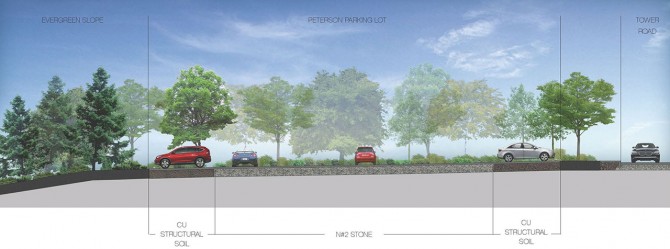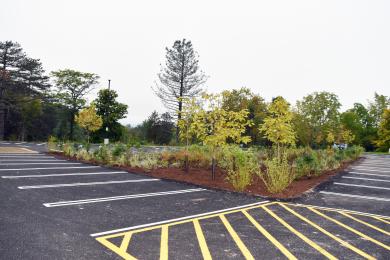![]()
Peterson Green Parking Lot
Sustainable Landscapes Trail at Cornell University
The Peterson Green Parking Lot was rennovated in 2018 as a state-of-the-art example of green infrastructure. It was designed by landscape architecture students and Cornell staff to demonstrate an alternative to traditional impervious parking lots and the resulting storm water runoff.
Return to Sustainable Landscape Trail Sites Homepage
Overview
At first glance, this parking lot may look like any other, but there are hidden processes beneath the surface. Porous asphalt and the bioswale in the center of the parking lot allow stormwater to drain into the soil beneath the pavement. The Peterson Parking Lot was designed to slow and store stormwater, while filtering pollutants, watering the bioswale, and recharging groundwater.
As a cause of water pollution, runoff from impervious roads and parking lots collect oil, sediment and other pollutants – and carries this material into waterways.
Green infrastructure practices will turn this parking lot into a natural landscape by capturing rainwater where it falls, filtering out pollutants and reducing large volumes of runoff, said David Cutter, Cornell’s campus landscape architect.
The modifications were supported under Cornell's Green Innovation Grant Program, funded by the New York State Environmental Facilities Corporation.
The Peterson lot’s porous pavement allows storm water to drain into a stone reservoir below the lot’s surface, while CU-Structural Soil along the lot’s central bioswale (a landscape element designed to remove pollution) allows the roots of bushes and trees to succeed under paved surfaces.
Related Resources:
The parking lot is expected to be certified by both SITES, an initiative of the U.S. Green Building Council to certify sustainable land design and development, and by Parksmart, a rating system for green parking structures.
Visit the CLIPers web site for more information about the campus committee that meets regularly about the general health and viability of the landscape and miscellaneous campus landscape issues.


